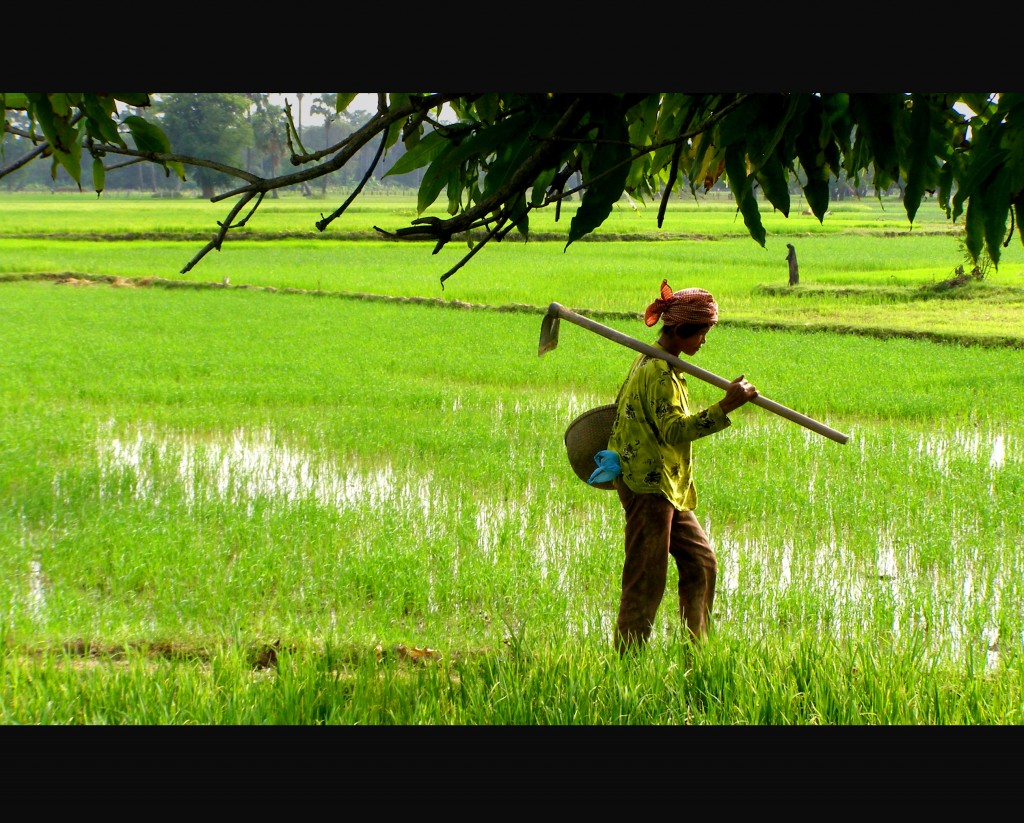Agriculture in Cambodia supports around 40 percent of the people.1 The size of the sector means that policies developed here have a significant impact on the whole country.2

Woman in the rice field. Photo by Iorena Pajares, taken on November 24 2007. Licensed under: CC_BY_NC_SA 2.0
Agricultural policy and administration is managed by the Ministry of Agriculture, Forestry and Fisheries (MAFF). There is close liaison with other ministries and national bodies where agriculture intersects with sectors such as industry, transport and trade.
Policy is focused on increasing skills and knowledge, productivity, diversification, processing capacity, storage, distribution and marketing. The government is reportedly aiming for agribusiness to make up 30% of GDP by 2025. It was 24% in 2013.3The National Strategic Development Plan 2014–2018 aims to raise the average value added per ha for all crops from US$ 997/ha in 2007 to US$ 1,450/ha in 2018. Currently, a significant volume of Cambodia’s agricultural products are exported to neighboring countries, where they are processed and then re-exported to other countries.4
Cambodia has significant room for growth in other areas too such as crop yields. A 2014 study by the Asian Development Bank, https://www.adb.org/sites/default/files/publication/77825/improving-rice-production-cambodia_3.pdf, found that Cambodia’s average rice yield ranks the lowest among almost all Southeast Asian nations. The study concluded that growing agricultural productivity required strengthened land titling and skills development, and improved access to finance.5
Policy direction
The National Strategic Development Plan 2014–2018 outlines the overall policy approach to agriculture in this way: “RGC’s vision is to modernize Cambodia’s agriculture based on a new approach and with changed scope and pace, to transform this sector from primarily depending on expanded use of available resources (such as land and other natural resources) and traditional agricultural inputs, into one which primarily depends on the application of techniques, new technologies, mechanization and irrigation to improve the yield rate, and diversify activities into high value crops, livestock, and aquaculture in an environmentally sustainable manner.”6
This is a clear policy shift from the growth in the last decade that came largely from farmland expansion.7Except for rice, the agroprocessing industry played a limited role.
The government has targeted agricultural growth of 5% per annum in the National Strategic Development Plan 2014–2018 (incidentally, a rate significantly below the growth forecast in the industrial and service sectors).8 If Cambodia can achieve this, then by 2030 its agriculture sector will be smaller but more productive. Agriculture’s share in GDP and total labor force would fall while land productivity would increase from $1,300/ha to $2,700/ha and labor productivity would rise from $1,200/person to $3,700/person.9
The World Bank suggests strong growth and a good outcome are possible if Cambodia’s agricultural sector follows four sets of policies:
- Maintaining a private sector-friendly policy environment
- Strengthening environmental sustainability
- Improving the quality of agricultural public programs and, where possible, increasing allocations to more effective programs
- Helping develop the agribusiness and agroprocessing industry.10
Cambodia Industrial Development Policy 2015–2025
Agricultural development is a key element of the Cambodia Industrial Development Policy 2015–2025.11There are four priorities – the development of the agro-industry; small and medium enterprises; transport and logistics; and skills training and worker development. The Council for the Development of Cambodia will oversee the implementation of the policy.
Targets in the policy include:
- Increasing agriculture-processing exports to 12%, a 4% increase on the projected figure for 2015
- Formalizing Cambodia’s small and medium enterprises
- Building expressways on key routes for faster transport of goods
- MAFF will establish areas similar to special economic zones, but for farming.
Agricultural extension policy
Announced in May 2015, this policy aims to make knowledge and technology accessible to farming communities, thus increasing productivity.12It will be overseen by staff from the Department of Agricultural Extension, working with development partners and the private sector. At the time the policy was announced there were only 70 extension officers at the national level and less than 1000 at the provincial level. At least 2000 will be needed.
Policy implementation will follow five steps: strengthening the regulatory framework around extension, building staff capacity, developing affordable and practical farming techniques, enhanced information and information delivery.
Crop-specific policies
In addition to broader strategic and policy work there are crop-specific strategies and policies, such as the Policy on the Promotion of Paddy Production and Rice Export and Cambodia Natural Rubber Development Strategy 2011–2020.
Last updated: 09 June 2016
References
- 1. Sok Chan 2017. Report says farming workforce halved. Khmer Times, 15 June 2017. https://www.khmertimeskh.com/8857/report-says-farming-workforce-halved/ Accessed 28 June 2017.
- 2. Julius Thiemann,‘Interview with David Van, rice expert’, The Phnom Penh Post, Accessed on March 14 2014. http://www.phnompenhpost.com/lift/interview-david-van-rice-expert
- 3. Muyhong Chan,‘Cambodia agrees agro-industrial framework’, The Phnom Penh Post, Accessed on July 1 2015. http://www.phnompenhpost.com/business/cambodia-agrees-agro-industrial-framework
- 4. Muyhong Chan,‘China weighs soybean, mango imports’, The Phnom Penh Post, Accessed on April 13 2015. http://www.phnompenhpost.com/business/china-weighs-soybean-mango-imports
- 5. Muyhong Chan, ‘Cambodia rice yields lowest’, The Phnom Penh Post, October 30, 2014 http://www.phnompenhpost.com/business/cambodia-rice-yields-lowest
- 6. National Strategic Development Plan 2014–2018, Ministry of Planning, Royal Government of Cambodia http://www.mop.gov.kh/Home/NSDP/NSDP20142018/tabid/216/Default.aspx
- 7. Cambodian agriculture in transition: opportunities and risks, World Bank, May 2015. http://www.worldbank.org/en/country/cambodia/publication/cambodian-agriculture-in-transition-opportunities-and-risks
- 8. Ibid
- 9. Ibid
- 10. Ibid
- 11. Kang Sothear ,‘PM Launches Grand Plans to Transform Industry’, The Cambodia Daily, August 27 2015. https://www.cambodiadaily.com/news/pm-launches-grand-plans-to-transform-industry-92645/
- 12. Muyhong Chan, ‘New policy to boost farming’, The Phnom Penh Post, Accessed on May 29 2015. http://www.phnompenhpost.com/business/new-policy-boost-farming

